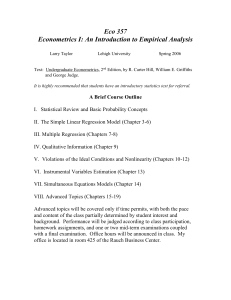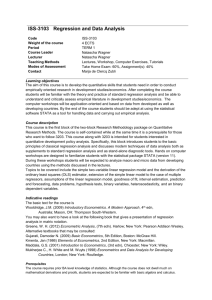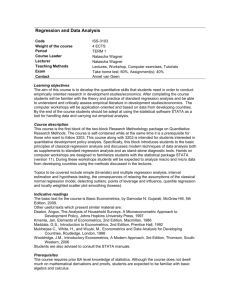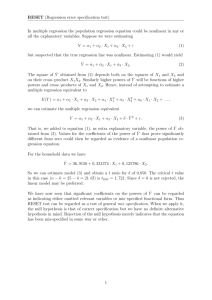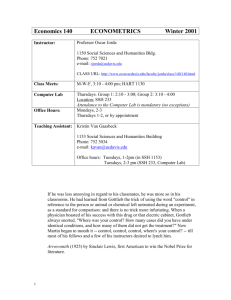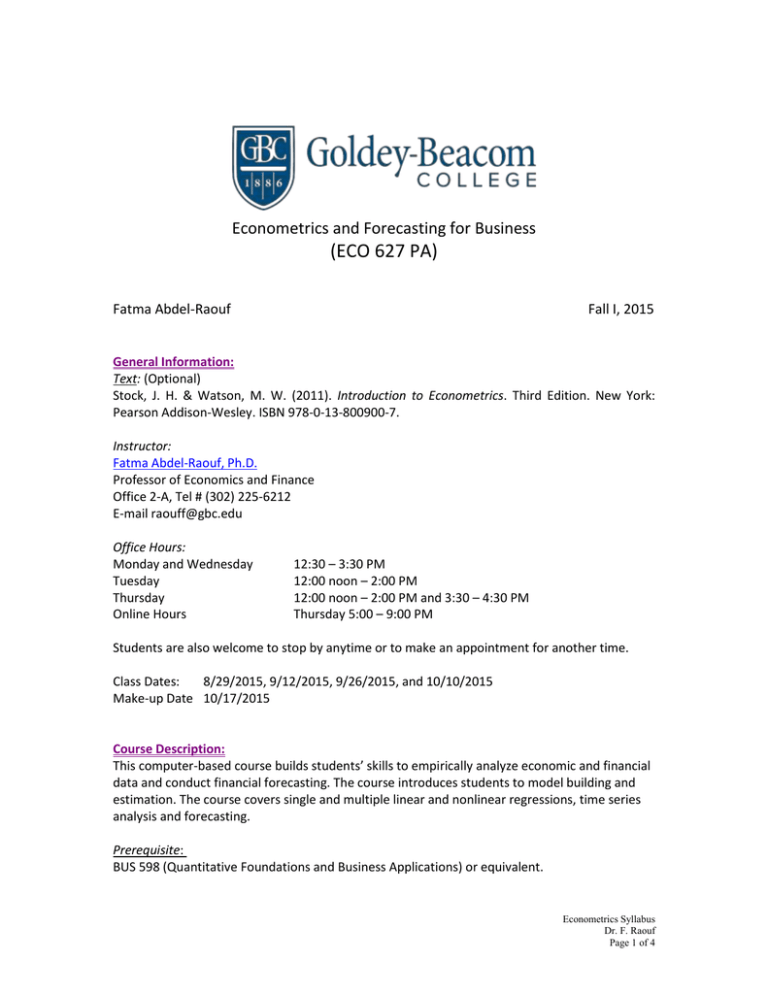
Econometrics and Forecasting for Business
(ECO 627 PA)
Fatma Abdel-Raouf
Fall I, 2015
General Information:
Text: (Optional)
Stock, J. H. & Watson, M. W. (2011). Introduction to Econometrics. Third Edition. New York:
Pearson Addison-Wesley. ISBN 978-0-13-800900-7.
Instructor:
Fatma Abdel-Raouf, Ph.D.
Professor of Economics and Finance
Office 2-A, Tel # (302) 225-6212
E-mail raouff@gbc.edu
Office Hours:
Monday and Wednesday
Tuesday
Thursday
Online Hours
12:30 – 3:30 PM
12:00 noon – 2:00 PM
12:00 noon – 2:00 PM and 3:30 – 4:30 PM
Thursday 5:00 – 9:00 PM
Students are also welcome to stop by anytime or to make an appointment for another time.
Class Dates:
8/29/2015, 9/12/2015, 9/26/2015, and 10/10/2015
Make-up Date 10/17/2015
Course Description:
This computer-based course builds students’ skills to empirically analyze economic and financial
data and conduct financial forecasting. The course introduces students to model building and
estimation. The course covers single and multiple linear and nonlinear regressions, time series
analysis and forecasting.
Prerequisite:
BUS 598 (Quantitative Foundations and Business Applications) or equivalent.
Econometrics Syllabus
Dr. F. Raouf
Page 1 of 4
Learning Goals:
1. Students will demonstrate how to test a hypothesis and construct a confidence interval for
any population mean(s).
2. Students will estimate simple and multiple linear regressions, test a hypothesis, and construct
a confidence interval.
3. Students will construct a nonlinear regression, transfer it into a linear regression, and then
estimate it.
4. Students will identify the violations of the classical OLS assumptions and formulate a solution
to fix them.
5. Students will develop an understanding of different forecasting methods, how to apply them
to time series data, and predict the future values for these time series.
6. Students will perform a regression analysis using Excel.
Method of Instruction:
The instructor is planning to conduct this course as follows:
Lectures: Fully explain the materials covered with several real world examples to
clarify the materials.
Applications: Help students apply and understand the topics covered.
Course Requirements:
Final Course Project (Tuesday October 14, 2015)
Assignments and Case Studies
Method of Evaluation:
Final project counts 50% of the grade.
Assignments and case studies count 50% of the grade.
Note the Following:
Extension for the final project will be given in real emergency only.
All assignments and case studies are to be submitted electronically via:
1. Campus Web
or
2. Email attachment
All assignments are due by the end of the day Saturday following the class meeting. Late
assignments are penalized by taking one point off the grade. Assignments are not accepted
after the answer is already posted on Campus Web.
Grade for the course is based on curving the total course grade for students at the end of the
semester. The grade distribution will then be compared to the College’s grading scale. The
student will be granted the higher of the two grades. Goldey-Beacom College grading scale is
A+
95-100
B
80-84.9
A
90-94.9
C+
75-79.9
B+
85-89.9
C
70-74.9
Students are expected to attend all classes, to be in class on time, to stay in class until the end
of the class, not to interrupt the class in any way, and to participate in class discussion.
This course is governed by the Academic Honor Code and the Respectful Learning Environment
Policy of the College. Any violation of this policy will be penalized. The web site for the Academic
Honor Code is http://www.gbc.edu/advisement/honorcode.html
Econometrics Syllabus
Dr. F. Raouf
Page 2 of 4
Course Outline
I. Foundations of Econometrics
1.1 Introduction to Econometrics
1.1.1 What is Econometrics?
1.1.2 What is Regression Analysis?
1.1.3 Causal Effects
1.1.4 Types and Sources of Data
August 29th, 2015
(Chapter 1)
1.2 Review of Probability
1.2.1Probability Distribution
1.2.2 Conditional Expectation and Variance
1.2.3 Commonly Used Distributions
1.2.4 Sampling Distributions
(Chapter 2)
1.3 Review of Statistics
1.3.1 Estimation
1.3.2 Confidence Intervals
1.3.3 Hypothesis testing
1.3.4 Testing for Two Population Means
(Chapter 3)
II. Fundamentals of Regression Analysis
August 29 – September 26
2.1 Linear Regression with One Regressor
(Chapter 4)
2.1.1 The Linear Regression Model
2.1.2 Estimating the Coefficients of the Linear Regression Model
2.1.3 Measures of Goodness of Fit
2.1.4 The Least Squares Assumptions
2.2 Hypothesis Testing and Confidence Intervals for
Linear Regression with a Single Regressor
(Chapter 5)
2.2.1 Testing Hypothesis for one of the Regression Coefficients
2.2.2 Confidence Intervals for a Regression Coefficient
2.2.3 Testing Hypothesis and Confidence Intervals when X is a Binary Variable
2.3 Multiple Regression Analysis
2.3.1 Omitted Variables Bias
2.3.2 The Multiple Regression Model
2.3.3 OLS Estimators in Multiple Regression
2.3.4 Measures of Goodness of Fit in Multiple Regression
(Chapter 6)
2.4 Hypothesis Testing and Confidence Intervals in Multiple Regression
(Chapter 7)
2.4.1 Hypothesis Testing and Confidence Intervals for a Single Coefficient
2.4.2 Tests of Joint Hypotheses
2.4.3 Testing Single Restrictions Involving Multiple Coefficients
2.4.4 Reporting Regression Results.
Econometrics Syllabus
Dr. F. Raouf
Page 3 of 4
III. Violations of the Classical Assumptions
September 26, 2015
3.1 Specification
(Chapter 8)
3.1.1 Choosing the Independent Variables
3.1.1.1 Omitted Variable
3.1.1.2 Irrelevant Variable
3.1.2 Choosing the Functional Form
3.1.2.1 General Strategy for Modeling Nonlinear Regression Functions
3.1.2.2 Forms of Nonlinear Functions
3.1.2.3 Interactions between Independent Variables
3.2 Multicollinearity
3.3 Autocorrelation
3.4 Heteroskedasticity
(Chapter 6 and Class Notes)
(Chapter 14 and Class Notes)
(Chapter 5)
IV. Nonlinear Regression
September 26, 2015
4.1 Polynomial Function
(Chapter 8)
4.2 Logarithmic Functions
(Chapter 6 and Class Notes)
4.2.1 Linear-Log Function
4.2.1 Log-Linear Function
4.2.3 Log-Log Function
4.3 Interactions between Explanatory Variables
(Chapter 14 and Class Notes)
4.3.1 Interactions between Two Binary Variables
4.3.2 Interactions between Continuous and Binary Variables
4.3.3 Interactions between Two Continuous Variables
V. Forecasting
October 10, 2015
5.1 Basic Concept
(Class Notes)
5.1.1 Time Series vs. Explanatory Forecasting
5.1.2 Basic Forecasting Tools
5.1.3 Measuring Forecasting Accuracy
5.1.4 Forecasting Methods
5.2 The Trend Analysis
(Class Notes)
5.2.1 Linear Trend
5.2.2 Nonlinear Trend
5.3 Moving Average Approach
(Class Notes)
5.3.1 The Simple Moving Average
5.3.2 The Weighted Moving Average
5.4 Exponential Smoothing Methods
(Class Notes)
5.4.1 Single Exponential Smoothing
5.4.2 Holt’s Linear Exponential Smoothing
5.4.3 Holt-Winters’ Exponential Smoothing
5.5 Autoregressive Integrated Moving Average (ARIMA) Method
(Chapter 14)
5.5.1 The Autoregressive (AR) Model
5.5.2 The Moving Average (MA) Model
5.5.3 The Autoregressive Integrated Moving Average (ARIMA) Model
Final Course Project
October 10, 2015
Econometrics Syllabus
Dr. F. Raouf
Page 4 of 4



